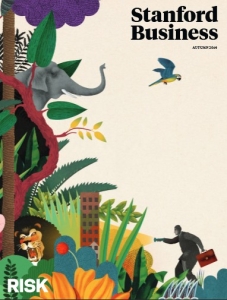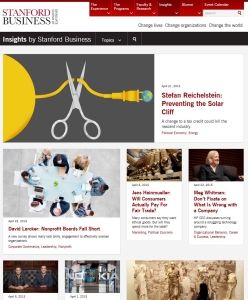By Beth Renaud
Marketing Manager/Lane Press
For traditional publishers with a predominantly print-first workflow, the idea of going “digital first” is not only overwhelming, it’s downright radical. Even for those who attempt it, the result often looks like a print process masquerading as a digital-first one—where everything still revolves, ultimately, around the print product we call “an issue.”

Stanford Business’ print magazine is built around a theme and pulls from content previously published online.
Two years ago, Stanford Graduate School of Business threw out the idea of an issue as we know it, dispensing with the notion that content should appear in print before being posted online. Editors even decided to let content live online long before being published in print. Whoa, right?
At last month’s CASE Editors Forum, where alumni magazine editors gather each year to find inspiration and share ideas, Stanford Business Editorial Director Michael Freedman explained why—and how—he and his team not only upset the apple cart but completely upended it.
In his presentation, “Building a Digital-First Shop,” Freedman emphasized that his team didn’t set out with this or any other specific end goal in mind. In fact, what they set out to do was learn more—much more—about what the magazine’s readers wanted and to deliver that.
Here’s (some of) what they learned:
- Their readers want a print magazine—and they also want content online.
- They want content in the forms that suit it—whether that’s text, video, audio, photos, or infographics.
- They appreciate receiving the same content through multiple channels—including social media, digital syndication, email, and YouTube.
- Timing across platforms is irrelevant. In print first? Online first? Lag-time in between? Doesn’t matter.
Stanford Business staff analyzed its readers’ feedback, made sweeping changes, and ended up with a workflow that starts online. Freedman and his team first publish individual pieces to their website, Insights by Standard Business. Then, they post and promote content on social media, where they have attracted over a million followers. Next, content appears in the school’s email newsletter. Last but not least, some content is printed in the magazine, which mails to readers three times a year. The editorial team plans a theme for each issue and pulls together appropriate content from what has been published online. Each feature gets a fresh, print-focused design and a new headline.
How is the new process working? According to Freedman, the proof positive is a more engaged audience—both online and in print. Reader surveys and digital metrics tell them so.
Is Stanford Business’ strategy right for you? Maybe—but the takeaway is how the team arrived at its digital-first workflow. The process can be applied to any publishing organization struggling with how to balance the production of both print and digital. Here’s how to get started:
-
Identify the goal.
An understanding of your goal sets a solid foundation for making changes that will get you there. It’s critical to step back periodically and ask, “Who are we?” The answer will evolve over time and promote a sense of ownership among staff. Freedman suggests asking both internal and external stakeholders questions such as: What are the goals of our institution (or organization)? What do we want to evoke in our readers? How do we want to present ourselves? What adjectives describe us? (Get a taste of Stanford’s own conclusions on their About and Magazine pages.)
-
Understand readers’ preferences.
“It’s not enough to focus on what we want,” Freedman says. “We need to know what our audience wants.” To find out, Stanford hosted two focus groups, in New York and San Francisco, and conducted reader surveys. Ask targeted questions such as what content readers prefer and how they’d like to receive it.
-
Adapt and deliver.
Based on what you hear from your audience, be willing to “let it go,” as Disney’s popular movie character, Elsa, would say (Freedman’s illustration, for the record). In other words, rethink everything you know about your current publishing workflow, he suggests. In doing so, you’ll be in a better place to hear, understand, and deliver what your audience really wants.
-
Measure results.
Are your workflow changes working? Feedback loops are essential and may be as simple as keeping a close eye on digital analytics or as complex as conducting periodic reader surveys and convening focus groups. Reader feedback and usage data not only gauges where you are, but will help you see where to go next.
. . . . .
Join us on Twitter and LinkedIn to share your thoughts & opinions.


